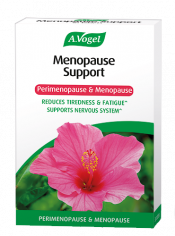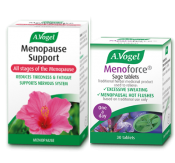Read the full video transcript below
Today's topic
Hello, and welcome to my weekly video blog. And today on A.Vogel Talks Menopause, I am going to be talking about those horrible varicose veins. And in the UK, anyway, we're in summer, the weather is getting really lovely and we're wanting to be out in shorts and into our bathing costumes and maybe doing a little bit of sunbathing.
And we can become very self-conscious if we've got varicose veins. And one of the interesting things I've found just lately is that a lot of women are contacting me and they're saying either, "My varicose veins have got worse in the menopause," or suddenly they're finding that they've got varicose veins and they're wanting to know what happens.
So I'm going to look at what varicose veins are and how the menopause can affect it, and also a lot of the things that you can do to help yourself.
What are varicose veins?
So, basically, varicose veins are where the veins in the backs of your legs start to bulge. They might start to get a little bit crinkly. You might find you start to get cramps, a lot of discomfort and swollen ankles. And what happens here is that the veins take the blood back to the heart. And because it's working against gravity, the veins have little valves in them. So the little valves are a bit like this, so when the blood gets pushed up the way, the valves open up, and then when there's a slight lull in the heartbeat, the veins close and that stops the blood falling all the way back down to your ankles.
What goes wrong?
The problem here is that as we get older, the veins can start to break down. They can start to go a little bit wonky. And what happens then is they don't hold the blood, so the pressure of the blood can actually push the veins open. And that then puts added pressure on the veins below the valve, and the veins then can start to bulge out of the way.
It can also affect the localized circulation in that area. And very often with varicose veins, you will see little thread veins or spider veins appearing. You might find that your skin gets very mottled. You might find the skin gets very dry and papery. And for some people, this can actually develop into conditions such as varicose eczema. And also if the skin gets really bad, you can end up developing varicose ulcers.
How does this affect us in the menopause?
Now, the problem here in the menopause is that oestrogen can actually affect the integrity or the strength of our blood vessels too. So we've got maybe general weakening. So if you have had varicose veins, once you get to the menopause, because your oestrogen is falling, that can weaken the valves and weaken the veins further. So your varicose veins start to appear worse. And for some of you, you will find that because the oestrogen is falling, it's affecting the blood pressure, and you're starting to get varicose veins for the first time.
Are you prone to varicose veins?
So what else need you look at in order to see whether you're going to be prone to varicose veins?
Sedentary job
If you sit a lot, if you're in a sedentary job, if you're like me and you're sitting at a desk quite a lot of the time, then that can actually put a lot of pressure on the veins that can make you more prone to varicose veins.
Don't get a lot of exercise?
If you don't get a lot of exercise, and in the menopause, we've got fatigue, we've got loss of motivation, so these things can affect the way that we see exercise and we end up just not exercising at all.
Pregnancy
We can look at pregnancy, if you've had any children. Pregnancy can very often weaken the veins just because of the pregnancy itself, and then over the years those veins will weaken and you end up getting varicose veins.
Weight gain
It can also be weight gain can increase the likelihood of varicose veins. And we know that weight gain and weight control is quite a big issue in the menopause, too.
What can you do to help yourself with varicose veins?
So what can you do to help yourself with varicose veins?
Get up and get moving
If you're like me and you're sitting at a desk a lot of the time, you need to regularly get up and get moving. I've got just a little plain and simple timer. I set it for roughly 45 minutes or an hour, and every time it pings, I get up from my desk and do a brisk walk around the building and then sit back down again. It takes me about five minutes but that keeps my circulation going.
Exercises
Do exercises if you can, if you're not too fatigued or you're not plagued by joint pains. So you can look at things like walking. Probably the best exercise for varicose veins. And if you walk, the actual movement of your calf muscles helps to push the circulation back up again. So exercise is great for alleviating some of the pressure that your lower legs will get under with the varicose veins.
You can look at swimming, cycling, and yoga. These are all really nice exercises for varicose veins.
If you feel that you can't move a lot, there's really simple exercises that you can do sitting on a chair. Just moving your legs up and down or standing on tiptoe or maybe just do one or two little step exercises at the bottom of your stairs. So you can certainly look at that.
Breathe
Remember to breathe. We want to oxygenate the circulation because that would just help things generally.
Regulate your temperature
And you need to regulate your temperature. And this is a difficult one because if you're getting hot flushes and night sweats then that is possibly going to affect the varicose veins as well, because all of a sudden, especially if you get a full-body hot flush or hot sweat, then the veins are going to be opening up an awful lot more. So if you're getting the hot flushes, try and deal with those if you can.
Remember sage is really great for hot flushes and night sweats. But try not to have hot baths, because that can affect the varicose veins. And don't soak in the bath for hours and hours. And don't have saunas because they can be really bad for the circulation in your legs.
Sunbathing
Sunbathing, if you're doing a lot of sunbathing then can be a factor too because you're getting a lot of heat on the back of the legs, and that will affect the veins, too. And one of the nice things you can do, a bit horrible in the wintertime but, is once you've had a shower or a bath is to give your lower legs a little bit of a cold shower just before you step out. That can really tone the veins up well.
What herbs/supplements can I use?
Horse chestnut
If you're looking at herbs or supplements, one of the best herbs is horse chestnut or Aesculus. This has been used for many, many years to help with varicose veins. And the problem today is there is very little else around that will help with varicose veins.
And I know a lot of women have said to me they've gone to the doctor and the doctor has told them that there's really nothing they can do until maybe the situation gets a lot worse.
So there is a lovely herb called horse chestnut. And it's a toner. And it does three things for varicose veins. It helps to tone and tighten the veins. So that can help to improve the appearance of varicose veins. It also helps to seal the little capillaries that very often get broken. So that can help with things like spider veins and your mottled skin. And it's also known to inhibit the enzymes that can weaken the blood vessels, too. So it's giving you a lovely all-round treatment for those varicose veins. And normally, most women will start to see a difference within may be two to four weeks.
Horse chestnut gel
There's also a horse chestnut gel. And this is a great one for hot weather because you can put it in the fridge and if maybe you've been standing on your feet all day, then once you come home from work, you can actually apply it to the legs. And it is lovely and cooling.
And the horse chestnut gel is also a really good one for swollen ankles if you go flying. So it's something that you can take in your hand luggage and apply maybe three or four times if you're on a really long-haul flight. So you can look at the horse chestnut, you can also look at other supplements.
Vitamin C and Rutin
Vitamin C is great for veins, really, very, very important here. And there's a compound called rutin, which is another one. You can supplements of rutin from your health food shop. And that's a really great one for toning up the veins too.
Look at your food
Antioxidants and Anthocyanins
You can look at food because certain foods can give you things called antioxidants. And antioxidants are those really brightly-colored fruits and berries, amongst other things. And berries are great because they have something called anthocyanins. Get that right, anthocyanins in them. And that's very good for toning and strengthening the veins, too. And your fruits and your berries are nice and high in vitamin C.
Avocado
Another great food for the veins is avocado. Avocados contain your vitamin C, they contain vitamin E, and they contain glutathione, which, again, all these can help to strengthen and support your veins.
Buckwheat
You could look at buckwheat. Buckwheat is a grain. It's like a grain. It's actually a grass seed but you would cook it and I suppose you could use it instead of rice. Buckwheat is really high in rutin so, you know, adding that into your diet maybe once a week can be very helpful from the rutin point of view.
Citrus fruits
And also citrus fruits. Again, you've got the vitamin C to help with the veins.
Vitamin C supplement
You can also look at a vitamin C supplement. But the important thing here, if you're using it for the veins, is to have it little and often rather than just one big high-dose a day, because that might not be quite so beneficial.
General foods
You can also look at certain general foods, stimulating foods such as ginger, such as pepper, nutmeg, cloves, onions, and garlic. These are lovely circulation-stimulating foods that will go to help supporting your veins as well.
Foods to avoid
The one, or the two main things here to watch that you should avoid for the health of your veins is sugar and also caffeine as well can be another one. So those ones are best avoided.
So hopefully, this has given you a few tips to help with your varicose veins. And I will look forward to seeing next week on A.Vogel Talks Menopause.









